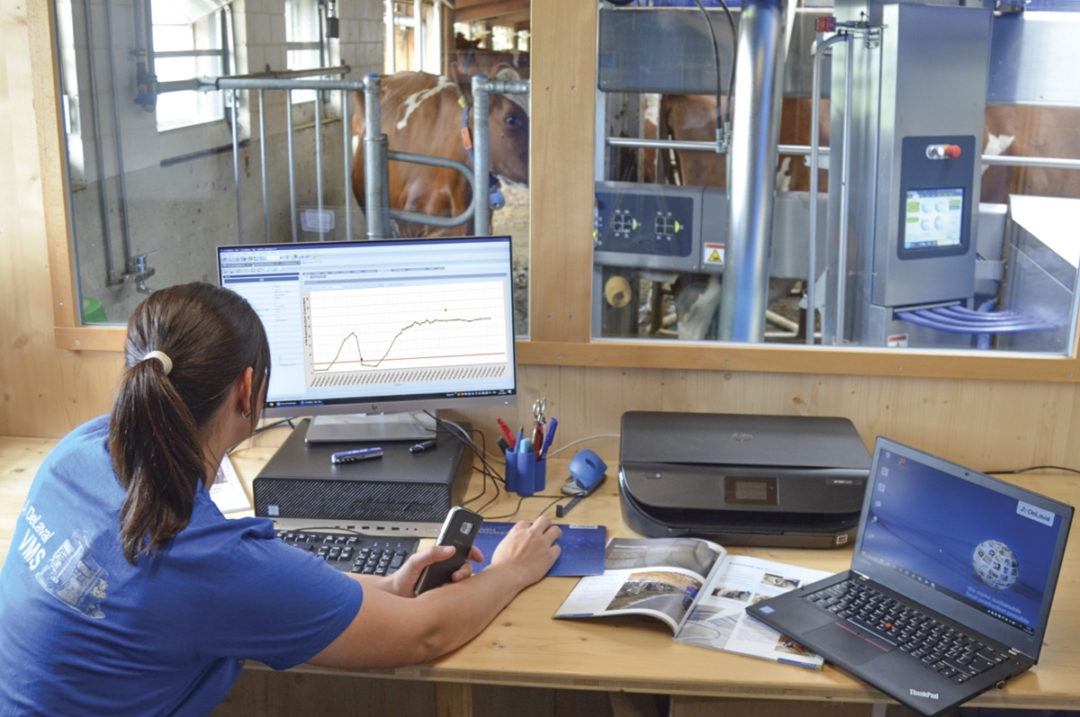Are you evaluating the prospect of adopting robotic milking on a large scale? Are you curious what the team for this facility will look like? In this article, I discuss the various roles that exist in a large robotic facility along with some suggested attributes to look for when hiring for these positions.
Every successful robotic facility must manage robot performance, cow health and data monitoring. Robots are machines, and machines need preventative maintenance, repairs and care. So, even though we no longer have to employ people to do physical milking, we still need employees to monitor the health of the animals along with the health and performance of the milking units.
Robot performance
From a robotic performance perspective, there are personnel that maintain the equipment and others that keep the units clean.
To maintain your robots, no matter how small your facility is, at least two people need to know how to do basic troubleshooting and repairs on robots. One person cannot be on call 24-7 and still make good decisions, especially where the smallest sound change or pattern change can signify that a robot needs an adjustment or repair.
The maintenance team’s priority is to verify that all robots are milking cows. Once that has been established, they can monitor and evaluate reports in the software to discover machines performing below desired key performance indicators. The team will then monitor these robots while they are milking to discover the root cause of their deviation in performance. Then they can make the necessary adjustments or repairs and run the proper calibrations to get them back in proper working order.
Outside of ensuring that the equipment is running smoothly, they will schedule time every week to watch each robot milk at least three cows and go through one total system wash. If you are experiencing issues with milk quality, then technicians will need to watch all the washes of problem robots until they resolve the issue. Scheduling in this monitoring time gives technicians the space to notice small things that may be out of alignment before they reach 100% failure. Along with simply monitoring and adjusting equipment, the team will need to go through a rotation of changing liners and hoses on a few robots a day to keep this task small and manageable.
When hiring technicians, look for individuals who are mechanically savvy and attentive to their surroundings. You will need people that can see and hear changes in the equipment’s performance and are accustomed to taking initiative to solve problems proactively. Robots are not as complex as people presume. These individuals do not have to have a technical degree if they are good communicators and can take direction from the equipment dealership’s technicians.
Another major task that falls under robot performance is hygiene. With many robots, managing the hygiene of the equipment takes more time than most budget for. There are different cleaning strategies that require varying amounts of time on different days. Some farms will scrub down their robots twice a day, inside and out, which takes about six minutes per machine. If you have 20 robots, that equates to a total of four hours a day. Some farms will hose the robots down once a day and scrub them once a day. It takes about three minutes to do a full hose down, so with 20 machines, this approach to robot cleaning would take a total of three hours. Other farms split the job in half: The morning cleaning crew will scrub the inside of the machine, and the afternoon crew will scrub the outside of the machine. That’s about four minutes per machine, twice a day, which is about two-and-a-half hours of cleaning a day.
We recommend maximizing your available milking time by cleaning your robots during system wash times. Most washes take between 45 minutes to an hour-and-a- half to complete. So regardless of which cleaning protocol your team decides on, you will likely need two people twice a day working on this task, with the size of the team increasing based on robot numbers.
Your robot cleaning team’s process should look like this:
- At the start of a system wash, visually inspect each robot to ensure that it has entered the wash process successfully.
- Look for any stop alarms or problems that may be preventing the robot from washing, and report those to the technical team.
- While cleaning, evaluate the equipment for rips or tears in liners and hoses, and listen to the wash process; communicate any discrepancies to the technical team.
The people completing this task, even though they are “just cleaning,” need to understand and value the importance of their work. Their diligence can be the key to finding issues before they become a problem, which allows the rest of the team to solve issues before they become a risk to milk quality.
Cow health
The team responsible for herd health focuses on training new cows and monitoring milking times, milking performance and animal health to ensure cows are thriving in the robotic setting. This team uses software reports, milk and activity data, and their observational skills to find and give attention to cows in need.
The most efficient way to do this work on a large scale is with sort pens. Some farms with cow-savvy employees are working cows individually in the freestalls to avoid sorting and managing a sort area, but if you choose this method, two people must be working together on each cow. With a properly designed sort pen, you should only need one person at a time to complete many of the necessary tasks.
Regardless of how this work gets done, herd-health team members will start their day by reviewing reports to determine which cows need attention for either illness, breeding, hoof trimming, vaccinations or milking issues. The only task for this group that is different from traditional milking is monitoring milking issues. A cow that experiences incomplete milkings (a milking where she gives less than 50% of what the robots expect her to give) should be checked for possible mastitis or problems milking in the robot. If mastitis is ruled out during sorting, then the team should get her in the robot and watch her milk to see if her feed manger needs adjusted to keep her more comfortable during milking.
You will need at least two members of this team that can work well on a computer to review and create animal attention reports. They need to be able to evaluate the data on their own; software and algorithms are great, but we don’t always need to sort every cow that pops up on a list. Sometimes an animal may be experiencing a dip in her immune system that she will recover from on her own. Employees that can analyze reports with their own knowledge and experience of what they are seeing in the barn will add a lot of efficiency to your facility.
Along with your herd managers, you will have hourly employees to fetch cows that need to be milked, manage stalls or loafing areas, and clean water troughs and crossovers. These individuals have a direct connection to your herd-health team, as they are spending the most time in the pens with the cows. These individuals should be constantly monitoring the cows to discover issues that may not be detected by the software. The key to utilizing this group to their full potential is setting up a communication strategy that allows them to easily share what they are seeing in the barn with the herd managers. Whiteboards in various locations of your facility or digital group chat apps are great ways to facilitate this communication. All the technology in the world can’t replace observant employees.
Data management
One person can perform data management tasks on your farm, or these responsibilities can be divided up among members of the other teams we discussed. Whichever way works best for your team, the key roles are entering health events, monitoring key performance indicators to discover issues with the robots or the cows, and ensuring the data being transferred to or from the robot software is error-free.
These tasks require people who are diligent with numbers entering and transferring information correctly. They also need to be strong communicators so they can take the information they find in the software and relay it to the appropriate team members to take action. This person may also be responsible for communicating key performance indicators to the dairy’s upper management and financial teams, so their attention to detail is critical.
As you can see, it is key for all of the employees in your robot facility to come to work with a passion. We have reduced the number of people running the facility, so it is necessary for the individuals in the barn to pay more attention and be better at taking initiative to solve problems. The more these employees learn about the equipment and the facility, the more indispensable they are to us. Remember, always have a backup or relief person to allow your staff the time they need to rest and tend to life’s emergencies. If they feel appreciated by you, then they will work harder for you.








